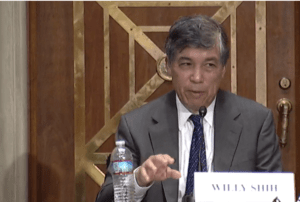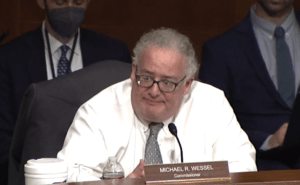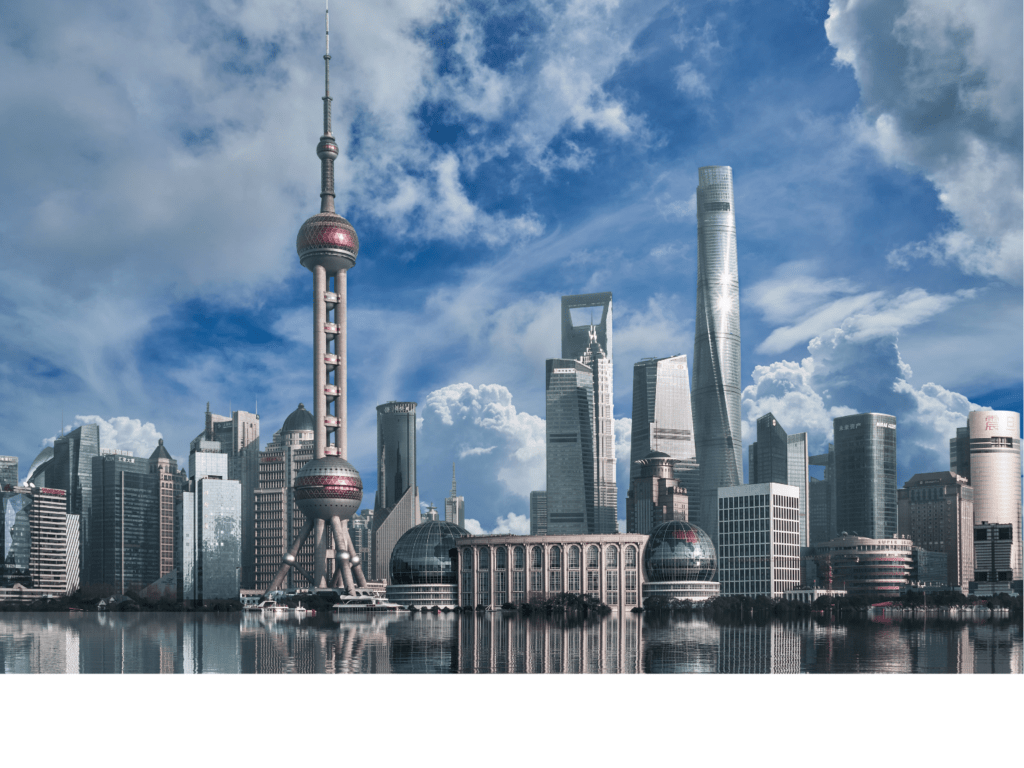The latest U.S. China Economic and Security Review Commission hearing on supply chain dependency had what some might call surprising comments from oral testimonials.
Within the overall question of China’s position in global supply chains was the issue of whether the world’s No. 2 economy had a comparative advantage in its economic model, a model that’s made it the go-to manufacturing hub of the U.S. Of the three who testified on July 9 before the Commissioners, two argued that China may not have the edge.
Yes, China has an overweight position in American supply chains, but that’s not a China policy, that’s American companies making that decision, they argued.
Moreover, China’s economy is more decentralized than we think. Provincial governments have a lot of power, often making things worse in terms of over-investment and over-capacity, ignoring the edicts from the CCP control tower in Beijing.
“China’s comparative advantages are not because of its industrial policy,” said David Bulman, Assistant Professor of China Studies at Johns Hopkins University’s School of Advanced International Studies. “It’s because of the provinces, who all have their own goals and ambitions. China’s supply chain dominance is also mostly due to taxes, (weaker) environmental regulations, geography, and a large, educated labor force.”
You can read Bulman’s written testimony here: [Testimony]
Bulman said that one sector where China enjoys a real comparative advantage is rare earths. This is thanks in large part to low environmental standards and the provincial goal of overcapacity to capture more government funding.
In high tech, central planning has had “underwhelming results,” Bulman said. For example, most semiconductor funding goes towards producing something fast, rather than into research and development.
There have been some successes in the central planning model thanks to creating demand – electric-powered cars and batteries were given as an example. Both are heavily subsidized in China. “Subsidies have to be massive in order to sustain demand for EVs in China,” Bulman said. “The demand is artificial. Plus the EV batteries they are making now are not long-range and those companies could easily be overtaken by foreign firms.”
Looked at another way, either blessing or curse, depending on whether you are a manufacturer or consumer, Chinese subsidies of emerging clean tech have kept the cost of EV batteries and materials down. The same can be said about solar, where oversupply in China – often a direct result of provincial governments rather than master planning – drove prices into the ground and often priced Western players out of the market.
“China’s dependency on foreign supply chains is just as troublesome,” said Mark Dallas, Director for Asian Studies at Union College, and an International Affairs Fellow at the Council on Foreign Relations.
You can read Dallas’ written testimony here: [Testimony]
Dallas’ main examples were all in information technologies and communications. Huawei is dependent from top to bottom on the hardware, software, and standard-setting processes which China does not control. “China’s dependence on U.S. technology is a key point of leverage,” he said, adding that those insecurities are driving China’s goal to catch up and leapfrog, investing in innovative technologies, often with the help of Western multinationals and venture capital.
Dallas advised not to make China too insecure or they are liable to push back, hold supply chains hostage, or threaten to take them over, as is the case with Taiwan Semiconductor, a leading producer of U.S.-designed chips of all types.
“It’s in our own interest to reduce China’s insecurity while increasing our own,” Dallas said. “Our relationship is like a circle. If China is insecure, its policies will be reactive and hurtful to us. And if we become too bellicose, then we are all going to be worse off.”
Commissioners played defense against this view that China wasn’t as dominant a force as one might think.
There was no one sector to pick on or save from China’s supply chain position. Vice-chair Kimberly Glas said, “What’s a strategic sector to protect? Is it the plastic in this water bottle,” she asked, holding up a bottle of water. “Is it this phone?” she said, holding up a phone. “Is it this?” she said, holding up alcohol gel wipes that became ubiquitous at the height of the Covid pandemic, and were often hard to find because the chemicals that go into making them are sourced from China.
“If we are going to counter China’s supply chain dominance and call certain industries strategic, it’s going to be a massive fight over what that means,” said Commissioner Derek Scissors. “If we decide it’s pharma, or its semiconductors that are strategic…then maybe you can have a more focused tax reform program catered to those sectors,” Scissors said, thinking out loud.
Willy Shih, Professor of Management Practice in Business Administration at Harvard Business School agreed with Scissors.
“Yes, a lot of countries do that. Not just China,” Shih said.
You can read his written testimony here. [Testimony]
In response to questions from Scissors on what can be done to counter supply chain vulnerabilities, Shih mentioned that the government needs to send demand signals to companies that there will be a buyer. He mentioned replenishing critical medicine stockpiles. “We can identify technologies and new processes for making titanium, for example. We have no sources for that. There are process technologies that can do that and mine it in Tennessee,” he said. “But the government needs to give demand signals to get that built here and bring some of that manufacturing back. You need to do things that favor long term, capital intensive projects where you may not see profit for 10 years. Why was China able to ramp up in things like personal protection equipment in the pandemic? They had the tooling industry there. We did not. You need demand signals to bring these industries back here.”
Shih was asked about pharmaceuticals that are made in India for the U.S. market but often are dependent on the key starting materials and sometimes even the active pharmaceutical ingredients that come from China labs. So while Bulman and Dallas noted that China too is dependent, mainly on tech and finance, Shih’s point more mirrored the view of the Commission. “We have a much broader dependence on China than most people realize,” he said. “China has a dependence on us, too, and don’t underestimate that interdependence. But…when people talk about dependencies on China, I can give you four more products for every one that you are thinking we are dependent on them for.”
 Commissioner Michael Wessel was in rare form. Frustrations mounted during the hearing. There was no magic bullet to save the U.S. from its Asia-centric supply chain, led by Chinese companies enmeshed with the U.S.
Commissioner Michael Wessel was in rare form. Frustrations mounted during the hearing. There was no magic bullet to save the U.S. from its Asia-centric supply chain, led by Chinese companies enmeshed with the U.S.
“The economics profession told us that in the long term, trade imbalances will be eliminated because currency values will adjust,” Wessel said, which of course never adjusted. He countered Bulman and Dallas’ view that China’s industrial policy often played backup to provincial governments. Wessel was not interested in whether the provincial governments listen to Beijing or not. Often the provincial governments went beyond, to the detriment of U.S. manufacturers, by overproducing and dumping goods into world markets, namely the U.S.
“I’d say China’s industrial policies have been enormously successful, maybe not in a market-friendly way. They are not a market economy, so they don’t gauge things the same way,” Wessel said. “When you look at what China is doing to incentivize U.S. companies to go to China, the classic market-based calculations are all in China’s favor. We are not investing. Even the $52 billion in the CHIPS package is a drop in a bucket to most people for what needs to be done (for the semiconductor supply chain). China’s measures success on the power of its leadership,” Wessel said. “They judge success based on different metrics, and not just on consumer gains like classical economists do.”
Some commentary from the Q&A session:
Sen. Carte P. Goodwin, Commissioner: How did China come to dominate rare earths? Doesn’t lax environmental policy give China a competitive advantage?
Bulman: Yes, of course, it does. That and labor standards can be seen as an advantage. I think that lax environmental standards play a key role, but China is not alone in that. Beijing put a lot of effort to shut down illegal overproduction (at the provincial level), which was almost half of all production in China and that move alone cut their market share in half.
Jeffrey Fiedler, Commissioner: What if China takes Taiwan by force and the U.S. government decides it will defend it? What would happen to supply chains? Has anyone thought about it?
Dallas: It would be catastrophic if that were to happen. That kind of conflict would have regional consequences and would undoubtedly be disastrous. So should we be making major changes in supply chains because of that threat and if the answer is yes, then what exactly would one do? I don’t think you should be reshaping all of Asian supply chains just out of the speculation that a war might take place.
Shih: Yes, China taking Taiwan would be more significant than many people appreciate and not just for semiconductors. I don’t think we are prepared for that. We should try to strengthen our position rapidly before any kind of conflict happened. It wouldn’t hurt to have a more conciliatory position and not poke the tiger in the eye repeatedly unless we think we can suffer the consequences. I don’t think we are in that position.
James Mann, Commissioner: The U.S. job losses in manufacturing all worsened after China entered the WTO.
Bulman: There is a definite “China shock” because it has the largest labor force in the world. But it’s not that China’s unfair policy hollowed out U.S. manufacturing. It’s that U.S. trade policy did not respond to that. The takeaway is not that China unfairly abused the system.
Alex N. Wong, Commissioner: What do you see as some new supply chain concerns to worry about?
Bulman: Robotics. We are about to have a massive oversupply of robots because it’s a new industry where you had a top-down policy to manufacture robots and then the provincial government implements that policy and creates demand and that impacts manufacturers abroad.
Kimberly Glas, Vice Chair: Regarding showing the demand signal for businesses to invest…do you think we are moving fast enough on? What policies should we try to move in the next year around these issues? We are trying to de-risk from China and bring some of these manufacturers onshore.
Shih: When we moved a lot of our metal casting offshore in the 90s, if you talk to small and midsized metal casters, they’ll say that the offshore guys got all the new equipment, and the U.S. companies have all the old equipment. So they are stuck with the low volume quick turnaround stuff. The locals need the revenue stream to get the cash flow to get that equipment for the future. So think in terms of government purchases where you can help, maybe with defense critical parts. Use that demand to drive the modernization of some industries. That is a short-term recommendation. Then how much do you want to rely on China? It all goes back to making sure you have healthy domestic capabilities. You need long-term buyers. I know a guy who just shut down a mask-making facility a couple of weeks ago. The government gave him a 90-day order. No one is going to invest in production for 90 days.”












